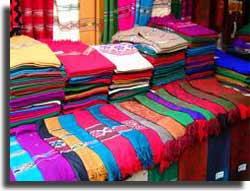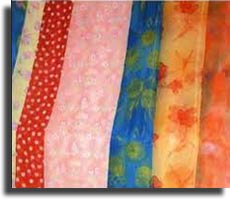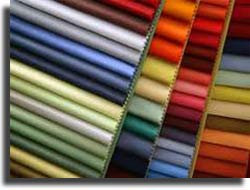| Size of the Industry | 1200 medium to large scale textile mills in India |
| Geographical distribution | TamilNadu, AndhraPradesh, Punjab, Karnataka, Maharashtra |
| Output per annum | 16% per annum growth rate and 1000 Million kg per annum |
| Percentage in world market | 7% share in the global market |
| Market Capitalization | 4% to the share of GDP |
| In 1850's the cotton textile industry, however, made its real beginning in Bombay.In the year 1854 the first cotton textile mill of Bombay was established by a Parsi cotton merchant then engaged in overseas and internal trade. Indeed, the vast majority of the early mills were the handiwork of Parsi merchants engaged in yarn and cloth trade at home and Chinese and African markets. The first cotton mill established in the year 1861 was at Ahmedabad, which was eventually to emerge as a rival centre to Bombay, which later spread the textile industry largely due to the Gujarati trading class. The cotton textile industry made rapid progress in the second half of the nineteenth century and by the end of the century there were 178 cotton textile mills; but during the year 1900 the cotton textile industry was in bad state due to the great famine and a number of mills of Bombay and Ahmedabad were to be closed down for long periods. |
 |

- Cotton Textiles
- Silk Textiles
- Woollen Textiles
- Readymade Garments
- Hand-crafted Textiles
- Jute and Coir
- The Indian Textile Industry today has approximately 1200 medium to large scale textile mills in India. 20%of these mills are located in Coimbatore (Tamilnadu).
- The industry has 34 million cotton textile spindles for manufacturing cotton yarn which account for 70 percent of India's textile exports. (China has 40 million cotton spindles.)
- Of the Indian textile yarn exports, almost 80 percent come from coarser yarns (counts below 40's). Consequently, there is a need to upgrade the technology.
- The domestic knitting industry is characterized by small scale units with facilities for dyeing, processing and finishing. The industry is concentrated in Tirupur (Tamilnadu) and Ludhiana (Punjab). Tirupur produces 60 percent of the country's total knitwear exports.
- Knitted garments account for almost 32 percent of all exported garments. The major players include Nahar Spinning, Arun Processors and Jersey India.
The Indian textile industry constitutes 14% to industrial production, 4% to the country's gross domestic product (GDP) and 17% to the country's export earnings, according to the Annual Report 2009-10 of the Ministry of Textiles.

- Indian Textile Industry covers 61 % of the international textile market and 22 % of the global market
- Indian Textile Industry is known to be the 3rd largest manufacturer of cotton across the globe.
- This industry of India claims to be the 2nd largest manufacturer as well as provider of cotton yarn and textiles in the world
- India holds around 25 % share in the cotton yarn industry across the globe
- India Textile Industry contributes to around 12 %of the world's production of cotton yarn and textiles
Investments in the Textile Industry
Around US$ 5.35 billion of foreign investment is expected to be made in India in the textile sector over the next five years.The textiles industry has attracted foreign direct investment (FDI) worth US$ 817.26 million between April 2000 and March 2010, according to data released by the Department of Industrial Policy and Promotion.- S Kumars Nationwide has formed a joint venture (JV) with Donna Karan International to design, produce and distribute the entire range of DKNY menswear apparel across the world except Japan for 10 years. The new venture will invest US$ 25 million for expansion of Donna Karan's menswear brand and expects to record sales of about US$ 140 million in the next three years.
- The Andhra Pradesh government has allocated over 1000 acres of land for the Brandix India Apparel City (BIAC) in the state's special economic zone (SEZ), which was inaugurated in May 2010. The apparel city is expected to attract an investment of US$ 1.2 billion (around Rs 5,400 crore).
- Private equity firms TPG and Bain Capital have picked up stakes in children apparel retailer Lilliput Kidswear for US$ 27 million and US$ 60.7 million respectively.
- Italian sportswear maker Lotto is planning to invest US$ 10 million over the next five years to capture 7 % of India's branded sports apparel and equipment market. This brand started its stand-alone retail chain in India in the year 2008, has 31 stand-alone stores across the country and plans to open 200 more such stores by 2015.
- World's leading lingerie brand, Germany-based, Triumph International, plans to invest over US$ 217 million in India to open 12 more flagship outlets and 30 additional EPS (Exclusive Partner Stores) during 2010.
 Recent Press Release
Recent Press Release
 INDIAN TEXTILE AT A Glance IN 2021 - 2022
INDIAN TEXTILE AT A Glance IN 2021 - 2022
 INDIAN TEXTILE AT A Glance IN 2020 - 2021
INDIAN TEXTILE AT A Glance IN 2020 - 2021
 INDIAN TEXTILE AT A Glance IN 2019 - 2020
INDIAN TEXTILE AT A Glance IN 2019 - 2020
 INDIAN TEXTILE AT A Glance IN 2018 - 2019
INDIAN TEXTILE AT A Glance IN 2018 - 2019
 INDIAN TEXTILE AT A Glance IN 2017 - 2018
INDIAN TEXTILE AT A Glance IN 2017 - 2018
 INDIAN TEXTILE AT A Glance IN 2016 - 2017
INDIAN TEXTILE AT A Glance IN 2016 - 2017
 INDIAN TEXTILE AT A Glance IN 2015 - 2016
INDIAN TEXTILE AT A Glance IN 2015 - 2016
 INDIAN TEXTILE AT A Glance IN 2014 - 2015
INDIAN TEXTILE AT A Glance IN 2014 - 2015
 INDIAN TEXTILE AT A Glance IN 2013 - 2014
INDIAN TEXTILE AT A Glance IN 2013 - 2014
 INDIAN TEXTILE AT A Glance IN 2012 - 2013
INDIAN TEXTILE AT A Glance IN 2012 - 2013
 INDIAN TEXTILE AT A Glance IN 2011 - 2012
INDIAN TEXTILE AT A Glance IN 2011 - 2012
 |
INDIAN INDUSTRIES |



 INDIAN TEXTILE INDUSTRY
INDIAN TEXTILE INDUSTRY 
